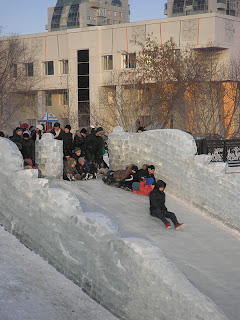Hello
everyone!
After an
early Monday morning flight, we had returned safely to our home city of Astana.
I would say that our adventure had ended, but that would be false – this place
constantly surprises us, in good ways and bad. One particularly pleasant
surprise was to return to see the river still frozen, but with some interesting
additions…
The boulevard
alongside the river is the starting point for numerous man-made ice slides
which descend onto – not into – the Ishim. Going into the river would surely be
fatal – though judging from the small dipping pools cut further up the frozen
waterway, some people test this theory out – so some kind people have cleared
the snow to leave an icy path at the bottom to slide along.
We watched
some children giggle and chuckle their way down the slopes and decided that we
needed to release our inner child. It is great fun – and much better on a small
plastic bendy sledge, purchasable for 200T from an old man at the top of the
slide. Cardboard is good, but the one time we used our green plastic seats we
reached the end of the track and crashed into the small wall of packed snow.
It was nice to have a few days in Astana to
relax and prepare for the new school term. It wasn’t that cold – we were told
that it reached peaks of -6 whilst we were away – so we were able to be
productive and have fun in the snow. We explored the area around our flat to
find many ice sculptures, ranging from the bizarre sight of an icy Winnie the
Pooh to the incredible sculpture of a Kazakh warrior.
Most of the
staff returned from their winter break on the weekend before school, and we all
met up at the Radisson Hotel for their Sunday brunch. 5,000T – a little over
£20 – for all you can eat and all you can drink. A very nice way to spend a
Sunday.
That was my
last drop of alcohol for quite a long time. Training for the RAK half-marathon
is now going to consume my life outside of school. Consequently, these blogs
will decrease in number over the next six weeks or so. However, I will
endeavour to unearth new discoveries in Astana to share with you all. Unless I spend
all of that time sliding…
Love you all
Matt


















































